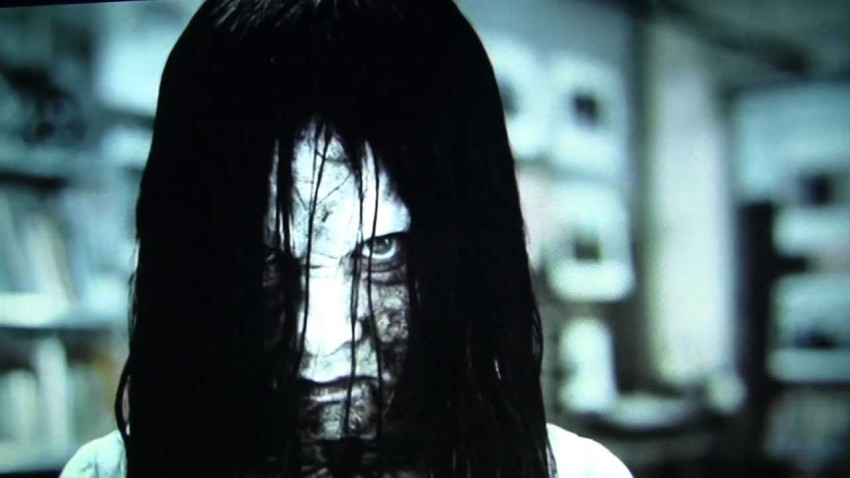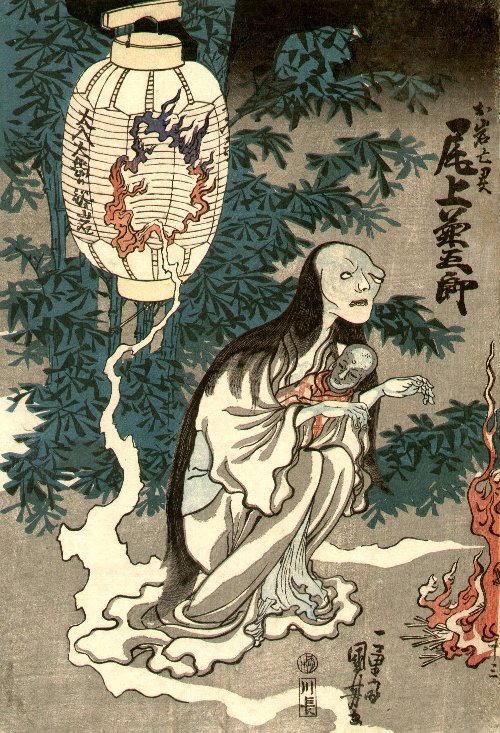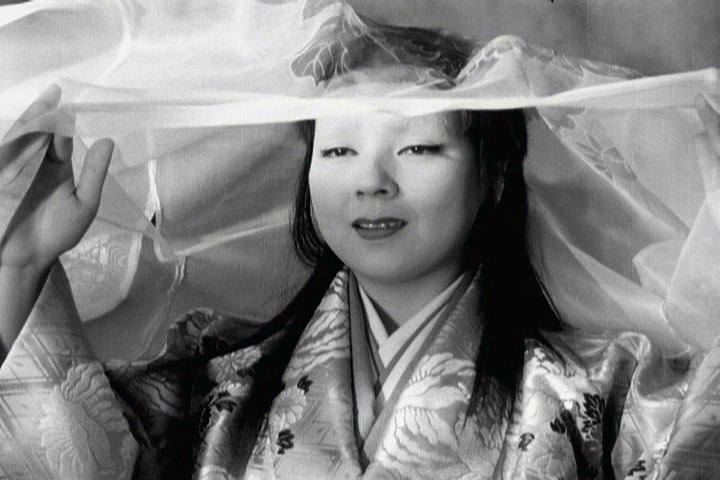Books: Yurei – The Japanese Ghost
August 14, 2016 · 0 comments
By Jasper Sharp.
 The clammy deathly-blue pallor, the single drooping eye leering through lank, matted black hair, the white cotton smock, the slow, spasmodic, Butoh-esque movements: there must be few out there unfamiliar with the imagery of the Japanese ghost since the shuffling form of Sadako first seeped into Western consciousness in Hideo Nakata’s Ringu (1998), gathering mass in a torrent of similar J-horror spook fests and the short-lived cycle of diluted Hollywood remakes. Since then, there has been no shortage of Western pundits springing forth to explain the origins and iconography of Japan’s distinctive brand of the supernatural, but none have been as far-reaching as Zack Davisson in his rigorous Yurei: The Japanese Ghost.
The clammy deathly-blue pallor, the single drooping eye leering through lank, matted black hair, the white cotton smock, the slow, spasmodic, Butoh-esque movements: there must be few out there unfamiliar with the imagery of the Japanese ghost since the shuffling form of Sadako first seeped into Western consciousness in Hideo Nakata’s Ringu (1998), gathering mass in a torrent of similar J-horror spook fests and the short-lived cycle of diluted Hollywood remakes. Since then, there has been no shortage of Western pundits springing forth to explain the origins and iconography of Japan’s distinctive brand of the supernatural, but none have been as far-reaching as Zack Davisson in his rigorous Yurei: The Japanese Ghost.
 If his name sounds familiar, it is probably due to Davisson’s sterling work over the past few years translating the weird and wonderful tales of Japan’s favourite yokai (spirit, goblin or otherwise fantastical being), Kitaro, the creation of the late Shigeru Mizuki (1922-2015), as well as the same author’s 3-part wartime magnum opus, Showa: A History of Japan. Davisson’s own fascination with the Japanese paranormal sprang from his realisation that his birthday on 15th August coincided with the country’s Festival of the Dead, Obon (not to mention the date of Japan’s surrender in 1945) – a time when the boundaries between this world and the next are at their weakest and in which the telling of chilling tales traditionally brought relief from the heat and humidity of the country’s stifling summers. Then, there was the much later haunting experience, as detailed in the book’s foreword, from when he lived in a gloomy apartment in the suburbs of Osaka with a suspiciously low rent…
If his name sounds familiar, it is probably due to Davisson’s sterling work over the past few years translating the weird and wonderful tales of Japan’s favourite yokai (spirit, goblin or otherwise fantastical being), Kitaro, the creation of the late Shigeru Mizuki (1922-2015), as well as the same author’s 3-part wartime magnum opus, Showa: A History of Japan. Davisson’s own fascination with the Japanese paranormal sprang from his realisation that his birthday on 15th August coincided with the country’s Festival of the Dead, Obon (not to mention the date of Japan’s surrender in 1945) – a time when the boundaries between this world and the next are at their weakest and in which the telling of chilling tales traditionally brought relief from the heat and humidity of the country’s stifling summers. Then, there was the much later haunting experience, as detailed in the book’s foreword, from when he lived in a gloomy apartment in the suburbs of Osaka with a suspiciously low rent…
The Japanese language sports umpteen different words to describe spiritual phenomena and concepts – obake, bakemono, mononoke, ikiryo, jibakurei, bourei, the aforementioned yokai and the transliterated form of the English gosuto are but a few, the nuances of many of them explained in the glossary. As Davisson explains, to translate yurei directly as “ghost” (or even more literally from its composite characters meaning “dim spirit”) ignores the cultural specifics that have given form to the modern-day understanding of the word, in much the same way that describing a leprechaun simply as an “Irish fairy” gives little idea of the role it plays in the contemporary Western imagination.
Yurei are more than just the equivalent of the ghosts of Western literature and film, which “are more of a storytelling device… an amorphous thing that suits the needs of the moment and can be used to incite fear or humour.” The concepts at the heart of the country’s two main belief systems – Shintoist ideas of kami spirits residing in all matter fused with imported Buddhist notions of karmic imbalance – mean that the Japanese ghost is a very different beast from the one that evolved from Christianity and the spiritualist movement of the Victorian era. “To most Japanese people, yurei are very, very real,” claims Davisson. “Yurei are a part of the everyday, wielding influence over the living, determining the course of events” – hence the tradition of Japanese Prime Ministers’ controversial visits to the Yasukuni Shrine to honour Japan’s war dead, and the degree of seriousness that greeted reported sightings following in the wake of the 2011 tsunami.
 Tales of yurei abound in Japanese folklore, but the dominant modern form comes from three famous literary models that form what Davisson describes as the ‘Three Great Ghosts’ of Oiwa, Otsuyu, and Okiku. Oiwa is a vengeful spirit first encountered in The Ghost of Yotsuya kabuki play, wronged by the cold-heated samurai Iemon, who returns from the dead to blight the fortunes of the house and drive her husband over the brink of insanity. Oiwa’s horrific appearance, her drooping eyes resulting from an early attempt to poison her, is unusual among the more typical seductive spectral beauties who populate Japanese ghost-lore, becoming an iconic figure in both woodblock prints and kabuki plays, famously reimagined by creators from Hokusai to Kuniyoshi (pictured), to Hideo Nakata, who used Oiwa as his template for Sadako in Ringu.
Tales of yurei abound in Japanese folklore, but the dominant modern form comes from three famous literary models that form what Davisson describes as the ‘Three Great Ghosts’ of Oiwa, Otsuyu, and Okiku. Oiwa is a vengeful spirit first encountered in The Ghost of Yotsuya kabuki play, wronged by the cold-heated samurai Iemon, who returns from the dead to blight the fortunes of the house and drive her husband over the brink of insanity. Oiwa’s horrific appearance, her drooping eyes resulting from an early attempt to poison her, is unusual among the more typical seductive spectral beauties who populate Japanese ghost-lore, becoming an iconic figure in both woodblock prints and kabuki plays, famously reimagined by creators from Hokusai to Kuniyoshi (pictured), to Hideo Nakata, who used Oiwa as his template for Sadako in Ringu.
The flamboyant theatre of Kabuki quickly established its conventions for the portrayal of yurei: elaborate lighting effects using shadows, smoke and firepots to obscure the actor’s feet; elaborate pulley devices known as chunori to make them float above the stage; the grey-blue aiguma makeup made familiar in Takashi Shimizu’s Juon; straggly wigs and, in some cases, hair pushed through special holes in the stage during materialisation scenes. Women’s long black hair has supernatural associations in Japan, which Davisson explains as embedded within the comb Oiwa is often portrayed as clutching – the word for comb, kushi, can be broken down into the components of ‘ku’ for suffering and ‘shi’ for death.
Unlike Oiwa, Otsuyu is a figure motivated by love from beyond the grave, not hate. She’s also the only one of the Unholy Trinity of Japanese ghosts not rooted in a true story, her archetype appearing in the compendium of erotically-tinged Buddhist morality tales from China. She was introduced to Japan reworked in a 1666 collection of ghost stories as “The Peony Lantern”, and subsequently referenced in everything from rakugo storytelling, to Lafcadio Hearn’s 1899 In Ghostly Japan, and movies, such as Satsuo Yamamoto’s The Bride from Hades (1968) and Chusei Sone’s overtly sexy treatment Hellish Love (1972).
And that leaves just Okiku, the only one based on a folktale rather than a literary source. In it, a lowly servant girl is cast into a well for losing one of her samurai master’s priceless plates and returns to haunt the area where it might have been lost. Many variants of the story exist across Japan, but the legend is now strongly associated with the well in the grounds of Himeji Castle, now a top tourist destination. Subsequent film versions have been based on a modernist Kabuki version first staged in 1916. However, Okiku appears to be the least suited to cinema of the three, with the last true adaptation, Kaidan Bancho Sarayashiki (Ghost Story of Broken Dishes at Bancho Mansion) directed for Toei by Juichi Kono, appearing as far back as 1957. Japanese ghost stories about women thrown into wells, however…
 Davisson describes the historical, political and artistic contexts in which such iconic figures were forged in a rich but spritely fashion to support the thrust of his argument, paraphrasing Lafcadio Hearn’s conviction that “to understand yurei and the Rule of the Dead – to understand the obligations of birth and death – is to understand much of Japan.” The colourful account of Hearn, “a creature himself as weird as anything he wrote about in his folklore sketches”, is one of the book’s many highlights, alongside the biographical details of the equally odd Akinari Ueda, the author of the aforementioned Ugetsu Monogatari collection of ghostly tales that formed the basis for Kenji Mizoguchi’s sublime 1953 film of the same name (pictured).
Davisson describes the historical, political and artistic contexts in which such iconic figures were forged in a rich but spritely fashion to support the thrust of his argument, paraphrasing Lafcadio Hearn’s conviction that “to understand yurei and the Rule of the Dead – to understand the obligations of birth and death – is to understand much of Japan.” The colourful account of Hearn, “a creature himself as weird as anything he wrote about in his folklore sketches”, is one of the book’s many highlights, alongside the biographical details of the equally odd Akinari Ueda, the author of the aforementioned Ugetsu Monogatari collection of ghostly tales that formed the basis for Kenji Mizoguchi’s sublime 1953 film of the same name (pictured).
Mizoguchi’s Ugetsu has all too often been used as a starting point in discussions about the roots of modern Japanese horror, but Davisson’s narrative of Sadako’s predecessors stretches right back to the dawn of cinema, to the first onscreen appearance of a yurei in Shinin no sosei (Resurrection of a Corpse, 1898). As the author points out, cinema (and later TV) treatments of Oiwa have appeared at least once every decade since an anonymously-directed film record of an original Kabuki performance in 1912 – although the Japanese Movie Database states this was first shown 1911. I have a few other (perhaps unduly anal) quibbles with some of the other parts about cinema, namely the statement that Hellish Love was “the first pink [ghost story].” In Behind the Pink Curtain, I detail two films directed by Kinya Ogawa for Okura Eiga in the late 1960s, The Case of the Lusty Living Head (Iki-kubi jochi jiken, 1967) and Ghost Story: Dismembered Phantom (Kaidan bara bara yurei, 1968), the former a sexed-up contemporary reworking of the Tokaido Ghost Stories – both were released in Japan as part of the ‘Okura Kaidan Sakuhin’ DVD box-set that also included Okinawa Hanging Phantom Ghost Story (Okinawa kaidan sakasa-zuri yurei, 1962) by Satoru Kobayashi, the director whose Flesh Market (Nikutai ichiba, 1962) is usually counted as the first example of a pink film. While on the subject, Takechi Tetsuji wasn’t prosecuted for obscenity for Daydream (Hakujitsumu, 1964) but for Black Snow (Kuroi yuki, 1965), and it certainly wasn’t “big-budget”, while the Roman Porno genre is, technically-speaking, not quite the same thing as pinku eiga. More serious is the listing of the release date of Nakata’s 1998 movie Ringu as 2003, which I can only assume is a typo that slipped past the editor, given the centrality of the film to discussions of J-horror.
These, and the inexplicable lack of an index, are but minor gripes about an otherwise highly readable and informative work. It is a beautifully packaged one, too, with a black cloth, embossed hardcover. Dozens of full-page colour plates of many of the Edo-era prints referenced in the text (although no film stills) are included, and it ends with a collection of over 50 pages of Davisson’s own translations of supernatural tales and other miscellanea confirming the significant role yurei have occupied in the nation’s psyche. All in all, this is a stunning achievement that should be on the shelves of anyone with an interest in Japan.
Jasper Sharp is the author of Behind the Pink Curtain. Zack Davisson’s Yurei: The Japanese Ghost is published by Chin Music Press.
Leave a Reply